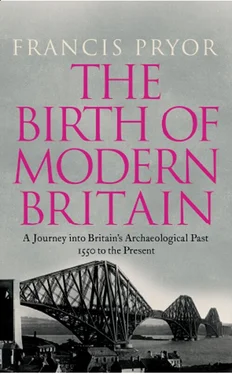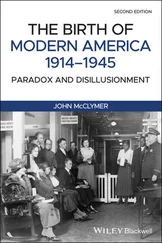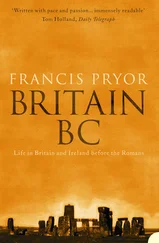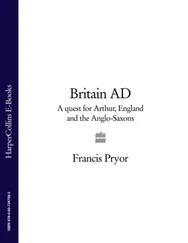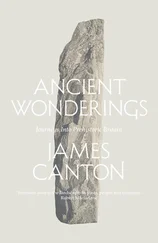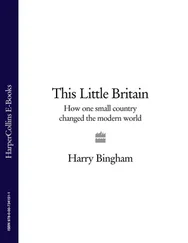Modern landscapes that arose through early enclosure, or enclosure by agreement, and by means of parliamentary enclosure appear very different. Not only do the early enclosures incorporate previous features, such as those reversed S boundaries, but although they are generally square-ish or rectilinear, their fields certainly don’t follow a rigid pattern and it is usually obvious that they arose as a series of distinct, one-off agreements. As such they tend to follow the shape and ‘grain’ of the topography rather better than the later (often parliamentary) enclosures which were accurately surveyed in. As a consequence, in these later enclosures dead straight lines and right angles predominate. Although many would disagree with me, I still like these later landscapes which I find have a charm all of their own – maybe it’s because I grew up in them that I feel at ease there.
Parliamentary enclosure took place rather later in our story, generally in the late eighteenth and nineteenth centuries. Essentially it was a response to the increasing pace of enclosure by agreement in those areas of central and eastern England where the medieval Open Field system had left a complex legacy of sometimes quite large parishes with numerous smallholdings belonging to many tenant and owner-occupier farmers. In such complex situations agreement was often difficult or impossible. So the passing of individual Acts of Enclosure was seen as a way through these problems. In theory at least it was a fair and transparent system where the process of enclosure was overseen by a parliamentary commissioner who also saw to it that the land was surveyed and parcelled up by official surveyors. But there was much scope for potential abuse: for example, areas of common land and so-called ‘wastes’ (where nobody claimed actual ownership) had to be reapportioned among the landowners of the parish. And as so often happens, the actual results were rather different and by the end of the process the big estates had done very nicely thank you, while substantial landowners and rising yeoman farmers also generally increased the size of their holding; more importantly, these holdings were now arranged more rationally and could be farmed much more efficiently. But small farmers often ended up proportionately worse off than their larger neighbours.
The first Parliamentary Act of Enclosure was passed in 1604 and in the eighteenth century these rapidly became the dominant method of enclosure, with some four thousand Acts passed between 1750 and 1830, covering about a fifth of England’s surface area. 18 The process continued through the nineteenth century. Apart from a contribution from the taxpayer, most of the cost of parliamentary enclosure was paid for by the larger landowners and this was probably why they tended to fare better than smallholders. It’s not hard to work out why. If one bears in mind what one learned as a child about the ratio of surface to volume, the men with the smallest holdings had proportionately the longer boundaries. These then had to be re-fenced and re-hedged at their owners’ expense. In many instances this was to prove too much so they sold out to their larger neighbours. 19
In the English Midlands parliamentary enclosure must be considered successful, but that cannot be said for everywhere, even in England. In upland areas of northern England, for example, parliamentary enclosure often ignored topography and was sometimes frankly irrational. If anything, it made efficient farming more difficult. 20
In Scotland enclosure was by agreement, or latterly by imposition of powerful landowners. In the Lowlands the process was well under way in the 1760s and 1770s and in the Highlands towards the end of the century, where they became known as the Highland Clearances; these enclosures often involved the clearance of entire rural populations to make way for sheep pasture and later for moorland game reserves. The Clearances continued late into the nineteenth century when huge numbers of people were either removed to new settlements often within the landowners’ estates along the coastal plain, or were sent abroad, principally to Canada. To give an idea of the scale of the Clearances, some 40,000 people were removed from the Isle of Skye between 1840 and 1880. 21
I think it would be a big mistake simply to think of the earlier post-medieval period in terms of big all-transforming movements, such as enclosure. Many poorer rural people lived outside the world of what one might term legalised land tenure. Theirs was an existence where possession was nine-tenths of the law and nowhere was this more evident than in the less prosperous parts of upland, non-Anglicised Wales. Because these holdings were, at best, quasi-legal, they have left little by way of a paper trail. So to track them down, my old friend Bob Sylvester (who initially made his name by sorting out the medieval archaeology of the Norfolk Fens) has had to turn to archaeology. 22
According to Bob, the traditional archaeological view of Wales was ‘a single undifferentiated upland landmass, appended to the western side of England’. 23 Unfortunately, such attitudes made no allowances for the distinctive landscapes of Wales which often arose through the action of people and communities that were very different from those further east. One such distinctive feature has been termed ‘encroachment’. 24 As the population of Wales began to grow from the later seventeenth century, and most particularly in the eighteenth and early nineteenth, impoverished landless people built themselves small houses and laid out smallholdings on the common land of the uplands, usually without the landowner (often the Crown) being aware. These people were often given moral and practical support by local parish councils who did not like seeing perfectly good land being left to stand idle. Sometimes landowners themselves encouraged such encroachment, especially if they were looking for labour to exploit coal and other mineral resources in these otherwise under-populated upland regions.
Informal settlements of this kind are fairly distinctive on the ground. They consist of a seemingly random scatter of small single-family households, within a couple of acres of land. Sometimes the more successful homesteads acquired the additional outbuildings of an upland farm and the various houses are usually served by a single, meandering lane. Encroachments are by no means confined to the uplands and can be found in valley floors, especially on land that was once poorly drained and uncontrolled, such as many of the tributary valleys of the Severn along the border country of Montgomeryshire and Shropshire. 25
Despite local difficulties of the sort we have just discussed, the rationalisation of the rural landscape brought about by enclosure of all types meant that farmers and landowners were now able to take practical measures to improve their land. In most cases this involved under-drainage, which was particularly effective in the clay lands of East Anglia, where huge areas were drained in the first half of the nineteenth century. Under-drainage involved the cutting, by hand, of a series of parallel, deep, narrow trenches containing brushwood, gravel, stone or clay pipes, these then emptied into ditches along the field’s edges, which in turn had to be deepened and improved. The work was often paid for by landowners. 26 The other major innovation which has left a distinct mark in the landscape, mostly of western Britain (although it was tried without the same success in drier East Anglia, too), was the extensive ‘floating’ of land through the construction of artificial water meadows in the years between 1600 and 1900. 27
These projects involved the digging of numerous channels to carry water from a main cut, usually alongside a natural river, and from there into a series of subsidiary streams carefully positioned to distribute it evenly across the meadow. These flooded meadows could be extensive, covering many acres, and their construction also involved the erection of numerous sluice gates which had to be opened and closed in a specific order, depending on what was needed. In fact the actual business of operating and maintaining water meadows required labour, plus considerable skill and experience, which might help explain why they failed to thrive after the opulent period known as Victorian high farming (which I’ll explain later) was brought to an end by the great agricultural depression of the 1870s. 28
Читать дальше
